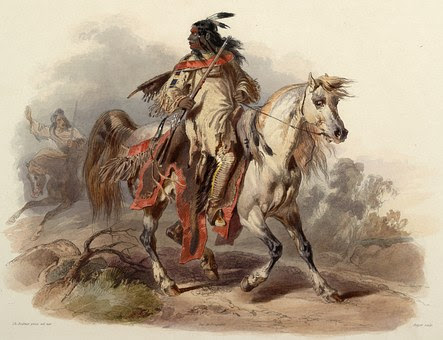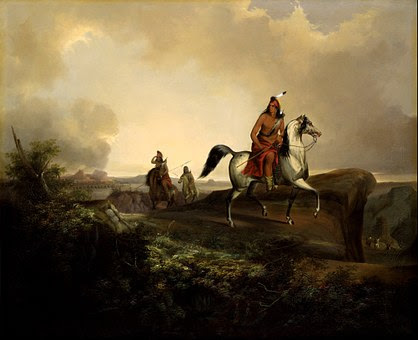In 1742 or 1743, the Jemison family emigrated from Ireland and settled on the American frontier, about 10 miles from present-day Gettysburg, Pennsylvania. They brought along a baby, Mary, who was born aboard ship during the journey.
In the 1740’s and 1750’s, the American frontier was the battle zone between Britain and France as they fought to control what is now the U.S. and Canada. Since the British and French military forces were limited, they looked to their settlers to be a colonial militia. They also formed alliances with Indian tribes by promising to keep white settlers out of their tribal lands. Each side turned a blind eye to the atrocities committed by their allies, white and Indian.
In 1758 when Mary Jemison was about 15 years old, her family’s farm was attacked by Shawnee Indians and their French allies. Mary’s family was killed in the raid. She later saw their scalps drying by a fire during her march into captivity.
Near Fort Duquesne (modern Pittsburgh, PA), the Shawnee traded Mary to two Seneca women who adopted her to replace a deceased brother. Replacing a dead relative with a captive was a common practice. Captives could also be used as hostages to negotiate limits on land grabs, or as ransom for weapons, or simply as a terror tactic.
The Seneca, Mary’s new family, were called “The Keepers of the Western Door” because they controlled much of western New York State. They were the largest and some believe the fiercest tribe in the Iroquois Confederation. The Seneca tribe is still based at Salamanca, N.Y.
In 1763, the Seven Years War (aka French and Indian War) ended and each side negotiated a return of their captives. Mary was taken to Ft. Duquesne, renamed Ft. Pitt (guess who won the war), to talk to the British negotiators. But at the last minute, her Seneca sisters decided they couldn’t bear to lose Mary and took her home again.
Mary lived with the Seneca tribe for the remainder of her life. Her first husband died a few years after they married leaving Mary distraught with grief. Like many grieving spouses, she eventually recovered and remarried in 1765. Her second marriage lasted 50 years.
Mary was offered another chance to leave the tribe in the 1780’s after the American Revolution. But she feared that white people would despise her and her half-Indian children. Besides, in Seneca society, women had political, economic, and social powers that white women would not gain until the 20th century. Women can understand why Mary stayed with the Seneca, even if her male biographer didn’t get it.
Mary died in 1833 at the age of 90. Her descendants live in Ontario, Canada, and upstate New York, some as Seneca and some as whites. A memorial to her can be seen in Letchworth State Park, south of Rochester, NY. Mary’s story is known outside the Seneca community because she told her story to James E. Seaver, a local doctor, in 1823.
A Narrative of the Life of Mrs. Mary Jemison, by James E. Seaver, is still in print. I recommend the version edited by June Namias which provides historical context for Mary’s life. A young adult version is Indian Captive: The Story of Mary Jemison by Lois Lenski.
Want to receive this blog straight to your inbox? Sign up for my mailing list.





